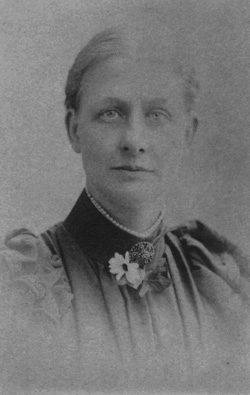
Council of Heads of Australasian Herbaria
Australian National Herbarium
Biographical Notes
 |
Council of Heads of Australasian Herbaria |
 Hope, Margaret Anderson (1848 - 1934)
Hope, Margaret Anderson (1848 - 1934)Born Tasmania on 24 May 1848, died in Hobart, Tasmania, April 1934.
Margaret, a flower painter, wax modeller and art teacher, was born in Tasmania and educated at Miss Garrett's Ladies College in Hobart. She gained a reputation for her paintings of Tasmanian wildflowers on wooden table tops and other furniture, which she exhibited widely.
By 1863 the Hope family were living in South Hobart, about 100 metres down the road from the Allport family whose artists, including Mary Morton Allport (1806-1895) were to influence Margaret in later years. She did not formally train as an artist, but frequently exhibited and sold her work professionally. In the Tasmanian press she was extolled in the same breath as the more established artists Louisa Anne Meredith (1812-1895) and Eliza Blyth (1820-1895):
"Among the most attractive articles are the ornamental tables exhibited by Mrs Charles Meredith, Miss Hope and Miss Blyth. The painting is beautifully done, and fully sustains the high reputation the artists have already secured."
Margaret worked for a while as a governess at Leith on the north-west coast of Tasmania where she is said to have also collected many botanical specimens [none survive in herbaria]. By 1879 she was an established art teacher in Hobart. In 1880 she won fourth prize in the Melbourne International Exhibition for an ornamental table, one of a number of local and national prizes in her career.
She was commissioned by the Chief Inspector of Stock, Queensland, to produce a series of monochrome illustrations for 'Plants reputed poisonous and injurious to stock', published under the authorship of F.M. Bailey in 1887. The plates are crudely lithographed including her handwriting and in some cases her signature. (thumbnail link right)
Hope was a prominent member of the Art Society of Tasmania. She served on the Council from 1892-1902 and frequently exhibited and sold her work. Other artists exhibiting flower studies at the time included Blanch Murphy (1864-1944), Ada Butler (1870-1914), Mary Augusta Greig (1845-1917, Isobel Oldham (1867-1958) and Mabel Hookey (1871-1953). Hope's asking prices were relatively high; in 1897 Native Laurel was exhibited for £5.5s, the most expensive in the flower studies section.
Her album, 'Wildflowers of Tasmania', was for a long time thought to be held at the Allport Library and Museum of Fine Arts, but this was not the case. On the 1 April 1990 the work appeard in a Sotherby's Melbourne book auction, listed as an "outstanding example of unpublished colonial Tasmanian flora". It sold for $12,100 to a collector of Australian botanical art. That collector offered it for sale in 2013 and it was finally acquired by the Allport Library and Museum of Fine Arts in 2014. These were publicly exhibited at the library in late 2015 and plates from this album were published to accompany the exhibition as: Character of the Blossum - Wildflowers of Tasmania by Margaret Hope 1848-1934.
Her panelled screen held by the Tasmainian Museum and Art Gallery is a striking work and regarded as an important representation of studio crafts practised in Tasmania.
Examples of her artwork:
Aristotelia peduncularis
Carpobrotus rossii
Eucalyptus globulus
Gaultheria hispida
Leptecophylla juniperina subsp. oxycedrus
Telopea truncata
Source: Extracted from: https://www.daao.org.au/bio/margaret-anderson-hope/biography/ and Caitlin Sutton's introduction to 'Character of the Blossum - Wildflowers of Tasmania by Margaret Hope 1848-1934' (2015)
Portrait Photo: Extracted from: dust-cover, 'Character of the Blossum - Wildflowers of Tasmania by Margaret Hope 1848-1934' (2015)
Screen Photo: http://static.tmag.tas.gov.au/decorativeart/objects/furniture/P1985.106/index.html